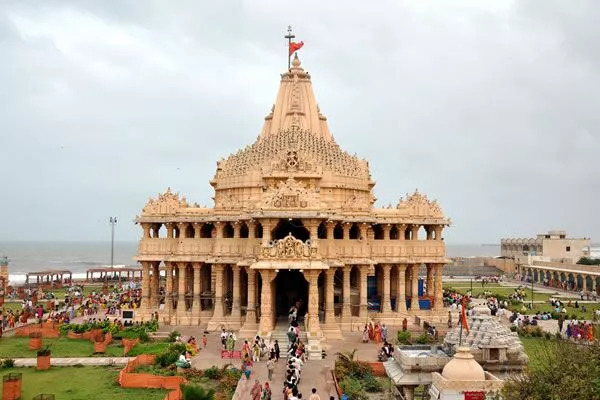WHAT IS THE MEANING OF JYOTIRLINGA?
Jyotirlingam, is a devotional representation of Shiva. Jyotirlinga means column or pillar of light. The pillar represents that there is no beginning or end. When Lord Brahma and Lord Vishnu argued regarding who is the supreme God. Lord Shiva appeared as a column of light, and assigned them a task to locate the ends of the pillar of light. However, they were unsuccessful. It is believed that the jyotirlingas are located where these columns of light fell. The Shiva Purana, mentions 64 original jyotirlinga shrines in India, out of which 12 are the most sacred and are believed to be Swayambhu, which means they were created without human intervention. Devotees consider visiting these Jyotirlingas to be very auspicious, as each temple is known for the supreme powers of Shiva.
- भारत के राष्ट्रीय ध्वज पर 10 वाक्य (10 Lines on National Flag of India in Hindi)
- सीआरपीसी की धारा 156(3) के अनुसार पुलिस जांच का निर्देश देते समय मजिस्ट्रेट अपराध का संज्ञान नहीं लेते: सुप्रीम कोर्ट
- Top Baby Girl Names That Start With D
- प्रेगनेंसी के दूसरे महीने के लक्षण
- Republic Day 2024 Shayari in Hindi : गणतंत्र दिवस पर शायरी पढ़कर भारतीय लोकतंत्र पर करें गर्व की अनुभूति!

12 Jyotirling name 12 Jyotirlinga Locations Somnath Gir, Gujarat Mallikarjuna Srisailam, Andhra Pradesh Mahakaleshwar Ujjain, Madhya Pradesh Omkareshwar Khandwa, Madhya Pradesh Kedarnath Rudraprayag, Uttarakhand Bhimashankar Pune, Maharashtra Kashi Vishwanath Varanasi, Uttar Pradesh Trimbakeshwar Nashik, Maharashtra Baidyanath Deoghar, Jharkhand Nageshwara Dwarka, Gujarat Ramanathaswamy Rameswaram, Tamil Nadu Grishneshwar Aurangabad, Maharashtra
Shree Dwadasha Jyotirlingam Stotram
श्री द्वादश ज्योतिर्लिङ्ग स्तोत्रम्: Saurashtre Somanatham Cha Shrishaile Mallikarjunam | Ujjaiyinyam Mahakaalam Omkarama-Maleshwaram |1|| सौराष्ट्रे सोमनाथंच श्रीशैले मल्लिकार्जुनम् | उज्जयिन्यां महाकालमोंकारममलेश्वरम् || Meaning - Somnath in Saurashtra and Mallikarjunam in Shri-Shailam; Mahakaal in Ujjain, Omkareshwar in Amleshwar. Paralyam Vaidyanatham Cha Dakinyam Bheemashankaram | Setubandhe Tu Ramesham Nagesham Darukavane |2|| परल्यां वैद्यनाथं चडाकिन्यां भीमशंकरम् | सेतुबन्धे तु रामेशंनागेशं दारुकाबने || Meaning - Vaidyanath in Paralya and Bhimashankaram in Dakinya; Ramesham (Rameshwaram) in Sethubandh, Nagesham (Nageshwar) in Darauka-Vana. Varanasyam Tu Vishvesham Tryambakam Gautamitate | Himalaye Tu Kedaram Gushmesham Cha Shivalaye |3|| वाराणस्या तु वश्वेशंत्र्यम्बकं गौतमी तटे | हिमालये तु केदारंघुशमेशं चशिवालये || Meaning - Vishwanath in Vanarasi, Triambakam on the bank of the river Gautami, Kedarnath in Himalayas and Gushmeshwar in Shivalaya. Atani Jyotirlingani Sayam Pratah Pathennarah | Saptajanma Kritam Papam Smaranena Vinashyati |4|| एतानि ज्योतिर्लिंगानि सायं प्रात: पठेन्नर:| सप्त जन्म कृतंपापं स्मरणेनविनश्यति || It is believed that those who recite the strota daily, dissolve all sins committed in the past seven births. Their wishes get fulfilled by Shiva’s grace.
SOMNATH

Somnath temple is the first Jyotirlinga. It is also called Deo Patan, located in Prabhas Patan, Veraval in Gujarat. The structure makes it a picturesque pilgrimage spot. The Dwadash Jyotirling pilgrimage commences at the Somnath temple. According to the Shiva Puranas, moon loved his wife Rohini the most out of his 27 wives. His wives represent the 27 Nakhshatras, who were the daughters of Daksha Prajapati. Due to the moon’s indifference towards his other wives, he was cursed by Daksha Prajapati that he would lose his lustre. He cursed the moon that his powers would decline day by day and he would lose his lustre, and he would eventually disappear also known as waning of the moon. An upset moon visited Somnath in Gujarat, along with his wife Rohini, and worshipped the Sparsh Lingam. Pleased with his devotion, Lord Shiva blessed the moon that he would regain his powers and lustre day by day and this cycle of waxing and waning will continue in perpetuity. Hence moon increases in brightness during Shukla Paksha for a fortnight and then wanes for a fortnight during Krishna Paksha. The moon was rechristened as Somachandra. Hence the place is known as Somnath. The temple was reconstructed in the past after destruction by multiple Muslim invaders. Mahmud Ghazni had invaded the temple in the 11th century. It is said that the Somnath temple was built around the 9th century CE. After India’s independence, the ruins were demolished. The temple was reconstructed in the Māru-Gurjara architectural style. The reconstruction began following the orders of Vallabhbhai Patel, the first Home Minister of India. It was completed in May 1951 after his death.
Map location- https://goo.gl/maps/23kYjq2QZymoYuU46
MALLIKARJUNA
.jpg)
Mallikarjuna Jyotirlinga temple or Srisailam temple is located at Srisailam in Andhra Pradesh, on the banks of the river Krishna. It is known as the Kailash of the South. As per the Shiv Puranas, Lord Shiva and Goddess Parvati could not take a decision regarding whether Ganesha or Kartikeya, should get married first. To determine who would marry first, a competition was conducted. Whoever would circumvent the world first would be declared as the winner. Lord Kartikeya immediately set off on his peacock, a mount. Lord Ganesha, on the other hand, went in circles around his parents and expressed that they meant the world to him. It is believed that walking in a circular manner around one’s parents is equivalent to going around the world. The pleased parents married Ganesha off to Siddhi (spiritual powers) and Riddhi (prosperity). According to a few legends, Buddhi which signifies the intellect is also believed to be Ganesha’s wife. When Lord Kartikeya learnt about this development, he was upset, left for Mount Krounch and decided to remain unmarried. Shiva and Parvati made a visit to Mount Krounch. Hence, a linga for Shiva and a Shakti Peetha for Parvati has been constructed at Mallikarjuna.
Map location- https://goo.gl/maps/hdiZC8i333Sfg4t86
MAHAKALESHWAR
.jpg)
Mahakaleshwar Jyotirlinga is the third Jyotirlinga which is located on the banks of the river Kshipra, in Ujjain, Madhya Pradesh. Mahakal is the only jyotirlinga facing the south, while all the other jyotirlingas are placed facing the east, since the south direction represents death. So, people worship Mahakaleshwar to prevent untimely death. As per a local legend, King Chandrasena, a Shiva devotee, ruled Ujjain. Shiva appeared in his Mahakal form and conquered his enemies. He agreed to reside in Ujjain to take care of the city. In the early part of the Meghadutam, in the 4th century, Kalidasa has described the Mahakal temple. As another story goes, a Brahmana named Vedapriya had four sons, Devapriya, Priyamedha, Suvrita and Suvrata. They used to read the Vedas, but a rakshasa named Dushana could not stand the idea of professing a religion. The four Brahmanas were attacked by the demons. Even when the demon threatened to kill the Brahmanas, they continued to pray to Shiva. Seeing their devotion, Lord Shiva appeared in front of them. Shiva destroyed Dushana and killed the soldiers. Hence Shiva is known as Mahakala.
Map location- https://goo.gl/maps/AvPSX8Fj3Fu3qDa49
OMKARESHWAR
Omkareshwar Jyotirlinga temple is located on an island at Khandwa in Madhya Pradesh. It is a sacred pilgrimage where the fourth Jyotirlinga is worshipped. There are different stories associated with this temple. As per Shiva Purana, Narada had visited the Vindhya mountains. It is believed that while the Vindhyas is the highest peak, Narada claimed that Mount Sumeru was superior than the Vindhyas, since the Gods were always present there. So, the Vindhyas prayed to Lord Shiva for being at par with Sumeru. Lord Shiva then appeared before the Vindhya mountains. Thus, the Omkareshwar temple came into existence.
Map location- https://goo.gl/maps/dg5DUM51L4n63niH6
KEDARNATH
Nguồn: https://tromino.eu
Danh mục: शिक्षा









